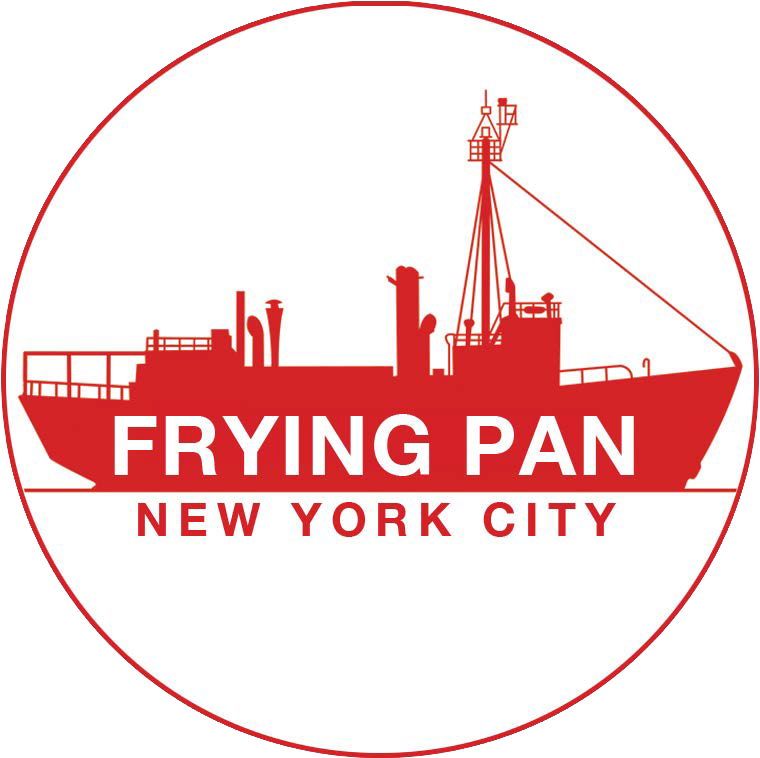Frying Pan & Pier 66 Maritime
In the early 1980's, John Krevey started an electrical contracting business called R-2 Electric, which had its office in a NYS DOT building on Pier 63, at the end of West 23rd Street..
By 1985, when the controversial Westway Project was finally scuttled, the west side of Manhattan had been a collection of rotting piers for more than a decade, with virtually no public waterfront access.
In 1989, John brought to New York the decommissioned U.S. Coast Guard Lightship Frying Pan (which had been lying on the bottom of the Chesapeake Bay) with the intention of creating a waterfront public access location and keeping alive New York City's working maritime history.
A vintage Lackawanna Railroad Barge (and an Erie Railroad caboose), which had been used to transport goods from New Jersey rails to Manhattan, was bought to help dock the Frying Pan, and Pier 63 Maritime was born. The site quickly became a crucial waterfront and Chelsea community-gathering place. Artists used it for painting and drawing (which continues to this day), Pier 63 Maritime hosted Free Movie Night with Community Board 4, and Frying Pan provided free boat trips for local organizations, schools, and others. And, by opening a free public dock, Pier 63 Maritime gave large vessels a site to tie-up, and it helped launch a non- motorized boating movement on the west side. Groups like Manhattan Kayak and New York Outrigger finally had waterfront access to launch their human-powered boats and a place to store them. This once desolate, forbidding area of Manhattan now thrived with a lively community spirit. Over time, the railroad barge was approved by the New York State Historic Preservation Office, the US Army Corps of Engineers, and the NYS Department of Environmental Conservation to be stationed in the protected waterway, and the concept of a waterfront public park began to take hold.
Lightship Frying Pan was designated a historic site in 1991 and is currently on the National Register of Historic Places. Years later, in accordance with Section 106 of the National Historic Preservation Act (16 U.S.C. 470f), the Frying Pan was written into the Programmatic Agreement that led to the development of Hudson River Park.
Construction of Hudson River Park necessitated the move in 2007 of the Railroad Barge and the Frying Pan from Pier 63 to the newly-built Pier 66a, where it attached to the Baltimore & Ohio Railroad Float Transfer Bridge, which is eligible for the National Register of Historic Places. A combination of grass-roots community groups and local politicians helped and supported the Frying Pan in negotiations with the Trust for the new location, and waterfront public access became an even greater success.
Today, the Lightship Frying Pan, along with its related business, Pier 66 Maritime, is an extremely popular café that is a Hudson River Park and New York City landmark institution enjoyed by locals and visitors from all over the world. The site is also a rent-free long-time home to the retired FDNY Fireboat John J. Harvey, which has Landmark & National Register Status and is part of New York City folklore for its heroic effort in fighting the World Trade Center fires on 9/11.
Frying Pan & Pier 66 Maritime continue to give back to the community in numerous ways by hosting many free public events. Local charities and Not-for-Profits hold fundraisers, a licensed teacher runs children activities with a nautical theme in the caboose, school & camp groups use the location, free of charge, and the Hudson River Park Trust itself has some of their own free public programs at the location. In recognition of this, in 2004, then-City Council Member David Yassky issued a Proclamation of the City to the Lightship Frying Pan, John Krevey was named "Hero of the Harbor" by the Metropolitan Waterfront Alliance, and Frying Pan & Pier 66 Maritime received the 2014 Chelsea Good Neighbor Award from the Chelsea Reform Democratic Club.
Thanks to the immense popularity of what was created by the Frying Pan team, Pier 66 Maritime has paid millions of dollars in rent over the years to Hudson River Park Trust. Frying Pan & Pier 66 Maritime built and provided the complete infrastructure, including the permitting & installation of utilities (water, sewer, electric, telephone) without HRPT needing to expend any of their limited resources. Additionally, Pier 66 Maritime is now a woman- owned business (with the passing of John Krevey) that employs over 125 people, seasonally, with good-paying jobs.
The Lightship Frying Pan has long provided a public benefit to the local community, and it helped pioneer the way New York City looked at its waterfront. Many of the guiding principles and policies of Hudson River Park Trust for waterfront public access, historic vessels, and public education about the area's rich maritime history were practiced by Frying Pan, Pier 63 and Pier 66 Maritime long before the creation of Hudson River Park. The team behind it has worked tirelessly through urban blight and the permitting process and Park construction and the unique challenges posed by waterfront locations to create a successful and popular destination in Hudson River Park. When Superstorm Sandy hit land, which knocked out most of Lower Manhattan and the Park, the highly-skilled and dedicated Frying Pan team kept the location unscathed (except for one broken pane of glass). It is this kind of expertise and institutional knowledge that has enabled the Frying Pan to be a completely self-sustaining operation, one that functions as a high-quality destination for the local community and all Park visitors at no cost to the City or the Trust. For over 25 years, the Lightship Frying Pan has been an important cultural amenity and a beacon to what is possible along the waterfront, and Hudson River Park and New York City are better for it.
